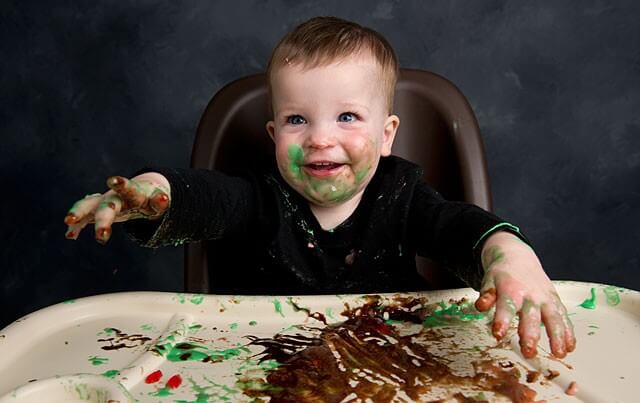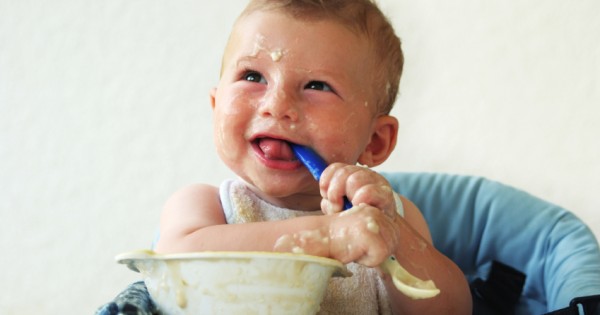What to Do When Your Baby Throws Food
Babies can make quite a mess when they eat, especially when they play with their food. So what can you do when your baby throws food?

When parents start complementary feeding with their baby, especially solids, situations often occur in which the baby plays with the food and throws it on the floor or all over the place. This happens with pretty much all children. In the beginning, there’s always going to be a stage in which your little will play with the food. But maybe as a mother, you probably don’t like it very much and feel like your little one is testing your patience. So, what can parents do when their baby throws food?
Before deciding to take any action regarding such behavior from your baby, you need to understand what’s behind it and think about what they’re trying to achieve with this behavior; are they trying to communicate something?
Children’s brains are programmed to learn. They’re little scientists, constantly doing experiments of all kinds. When they start to knead the food you’ve so lovingly prepared for them, they’re experimenting! Yes, they’re getting to know textures, temperatures, resistance to pressure, i.e. whether the food crumbles or falls apart, whether it stains the tray or the plate.
When your child throws food from the top of their chair to the floor, they’re experimenting with gravity. They’re discovering that things don’t float, that they fall; they’re discovering how fast the food falls, if it expands, or if it breaks when it hits the floor, if it stains the floor, if it gets wet, what sound it makes, among other things.

Sometimes your baby throws food because they’re playing
Playing with food is basically a very complete activity for babies. But sometimes, they may do it simply because they’re not hungry. Maybe because they nursed or had a bottle a little while before or because they’re going through a stage of having a little appetite. If eating is a secondary activity to play-learning, it’s probably because you’re child isn’t hungry, or at least not very hungry.
It’s important to understand that this behavior in itself isn’t a sign of any problem. It’s perfectly normal, considering infant development. The only problem really is when parents react so poorly to this behavior. Without realizing it, they feed into it, making this stage last longer and longer. And, at the same time, they’re also turning mealtimes into an unpleasant time for the whole family.
If you’re convinced that children do indeed learn by our example, then you’ll have the patience and peace of mind to let them be children and learn what they need to learn.
Tips if your child throws food
Put a plastic bag under your baby’s chair:
A large open plastic bag under your baby’s chair or highchair will make the clean-up task much easier for you. If you don’t want the food to get lost or dirty when it falls on the floor, this method will help you a lot because the food won’t touch the floor.
Offer very little food:
You can administer your child’s food and place it on their plate little by little. Start by giving them only a piece or portion at a time. When they start to throw it, you can start deciding whether to give them a little more or offer it again at a later time. You may even take this as a sign that they’re full for the moment.
Put the food on the tray of their highchair instead of using a plate:
Doing so avoids the risk of leaving a plate full of food within their reach that he can throw around like a frisbee.

Avoid any kind of forced behavior:
If your child refuses to open their mouth, in no way, under any circumstances, should you force them. Distracted or forced feeding can lead to a lot of problems with food later on, as well as being a very traumatic experience.
Set limits:
If you have a strong reaction to messy or wasted food, however valuable it may be as a learning activity for the child, it’s best to set limits with confidence. This certainly doesn’t mean that you’re going to deprive your child of learning and exploring, but that they’ll simply have to learn with other things or in other ways.
In this case, it would be good to be aware of the value of a sensory activity like this and find a way to allow them to have similar experiences in a way that’s acceptable to you. Boundaries are up to each family and should be designed to make it easier for each member to live with each other.
So, if your child throws food, you need to decide if it bothers you enough to set the boundary or if you can find a way to allow it without resentment. Playing with food is a valuable learning activity.
Ideally, you should be able to see it and allow it, at least in a controlled way, as such. But remember that you can also set limits and do it in a respectful way. Without losing your temper, without getting angry, without invalidating your baby’s emotions and developmental stage. Confidently, confidently, calmly, and lovingly.

